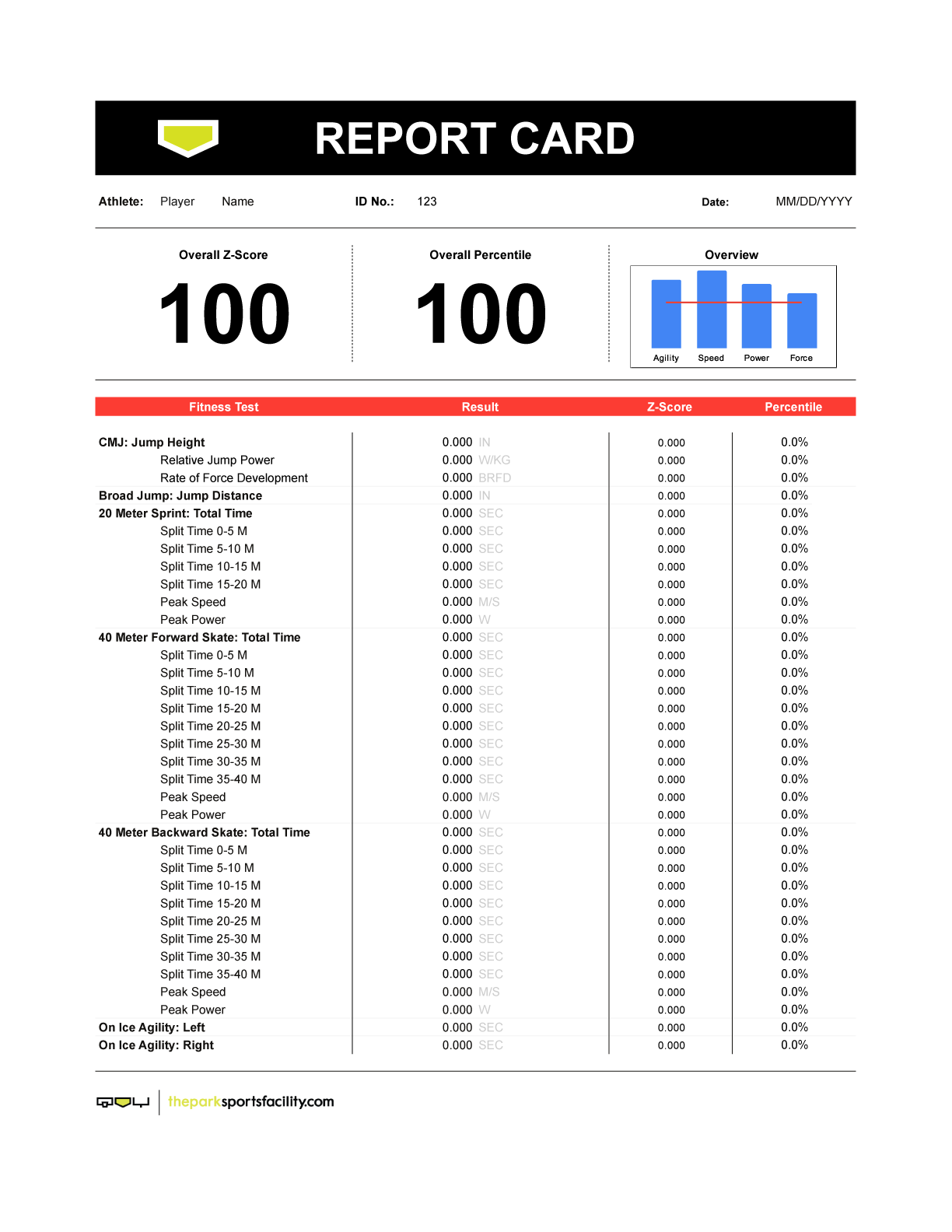
New Reporting Packs Available
Looking for more insight to your HHOF Combine test scores? Athletes can request an individual report card for just $25.
HHOF 2024 Combine Test List
Jump Station:
✓ Countermovement Jumps
✓ Broad Jump
✓ 20 Meter Sprint
✓ NEW! 20 Meter Reaction Test
On Ice Sprints:
✓ 40 Meter Forward Skate
✓ 40 Meter Backward Skate
On-Ice Agility Tests:
✓ Pro Agility (left and right)

ASSESSMENTS
Broad Jump: The broad jump is primarily used to measure a player’s short-area quickness and burst. Players jump from a standing position, and they must land balanced. Players cannot move forward or backward after landing. It’s a measure of lower-body balance and strength.
Equipment Used: Tape Measure
Test Metrics: Distance, Inches
Countermovement Jump (CMJ): The Countermovement Jump (CMJ) is a vertical jump test performed by having an athlete quickly squat to a self-selected depth and then jump as high as possible. It is the first jump in our force plate assessment and is used to both determine lower body power via jump height and to measure lower limb asymmetries.
Equipment Used: Dual Force Plates
Test Metrics: Height, Inches | Relative Power, Watts/Kg | RFD, Newtons
Iron Cross Shuttle: Goalie starts at bottom of circle. C-cuts, alternating feet to face-off dot. T-push to the left side of the circle and back to dot. Shuffle to the right side of the circle and back to dot. C-cuts to top of circle and backward c-cuts to bottom of circle.
Equipment Used: Timing Gates
Test Metrics: Time, Seconds
Pro Agility (PAT), On Ice: Participants straddle the start line, turn to the left and skate 5m, stop at a cone, skate 10m in the opposite direction, stop at another cone, and skate 5m back to the middle. Participants will do the test twice; first time starting with a left turn, and then with a right turn.
Equipment Used: Timing Gates
Test Metrics:Time, Seconds
Sprint, Forward, On Ice: The test involves skating a single maximum, predetermined distance, with split times recorded every 5 meters. .
Equipment Used: Timing Gates, or 1080 Sprint
Test Metrics: Time, Seconds | Peak Speed, Meters/Second | Peak Power, Watts
Sprint, Backwards, On Ice: The test involves skating backwards a single maximum, predetermined distance, with split times recorded every 5 meters.
Equipment Used: Timing Gates, or 1080 Sprint
Test Metrics:Time, Seconds | Peak Speed, Meters/Second | Peak Power, Watts
Sprint, C-Cut, On Ice: The test involves skating c-cuts a single maximum, predetermined distance, with split times recorded every 5 meters.
Equipment Used: Timing Gates
Test Metrics: Time, Seconds | Peak Speed, Meters/Second | Peak Power, Watts
20 Meter Sprint: The test involves running a single maximum, predetermined distance, with split times recorded every 5 meters.
Equipment Used: 1080 Sprint
Test Metrics: Time, Seconds | Peak Speed, Meters/Second | Peak Power, Watts
20 Meter Reaction Test: Athletes get a running start through a set of motion detecting timing gates. At the initial pass, the athlete needs to determine which gates to run through next by quickly noting which gates are lit up. The lights are activated randomly to measure reactive speed.
Equipment Used: Timing Gates
Test Metrics: Time, Seconds
SCORING
Percentile: A percentile rank indicates how well an athlete performed in comparison to the athletes in their peer group. The Park™ scores percentile rankings against a dataset of thousands of athletes across the globe grouped by age and gender. For example, an athlete that scores in the 75th percentile, is performing better than 75% of athletes their age and gender worldwide.
*For the Overall Leaderboards, we use a “group percentile” based on their specific test group instead of the worldwide percentile.
Group Percentile: The group percentile gives a percentage rank of the athlete’s performance compared to and isolated test group (in this case, the HHOF 2023 participants by age and gender).
Weighted Scores: Each test result represents a predetermined percentage of the overall score. Some test scores will be assigned a greater value according to the significance of that particular test.
Z-Score: A Z-Score compares an athlete’s individual performance to the test group’s average. Results are scored against participants of the same age and gender, and presented as positives (above average) and negatives (below average). For example, a Z-Score of 0 indicates the athlete scored the same as the group’s average, and a score of 1.0 would represent one standard deviation above the average.
RESULTS
Fastest Sprinter and Fastest Skater: Using the sprint test results, we can determine the athlete’s peak speed.
Calculated Metric: Meters/Second
Relative Jump Power: Absolute Strength (power) describes the total amount of force an athlete can produce, regardless of bodyweight or size. Example: The athlete who can generate the largest amount of power in their jump has the highest absolute strength.
Calculated Metric: Watts/Kg
Rate of Force Development (RFD): The rate of force development (RFD) is a measure of explosive strength, or simply how fast an athlete can develop force. Athletes with higher rates of force development have been shown to perform better during numerous physical performance tests.
Calculated Metric: Newtons
Peak Speed: A true peak is the absolute highest speed reached during a sprint, not the average speed during a peak zone or split.
Calculated Metric: Meters/Second
Peak Power: Peak power is the greatest output or production of work over a given amount of time. Power is able to account for a combination of strength, velocity, force and neuromuscular adaptations. Power tests help create an athletic profile and can also be used as an index of fitness or performance adaptation over time.
Calculated Metric: Watts
Ask us about benchmark testing and development packages!
